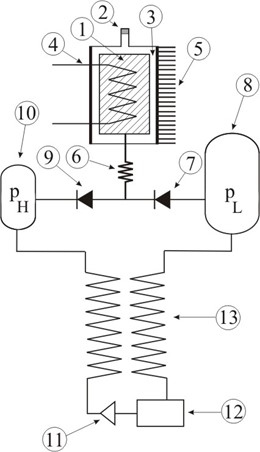Principle of operation of a sorption-based cryogenic cooler
A sorption compressor is a thermal compressor that operates with a sorber material such as activated carbon. Activated carbon is a material that by its highly porous structure has a very large internal surface so that it can adsorb large quantities of gas. By heating the sorber the gas is desorbed and a high pressure can be established. By expanding this high-pressure gas in a well-controlled way cooling can be obtained.

1: container
2: gas-gap actuator
3: gas-gap
4: heater
5: heat sink
6: aftercooler
7: low-pressure valve
8: low-pressure buffer
9: high-pressure valve
10: high-pressur buffer
11: restriction
12: evaporator
13: counterflow heat exchanger
Schematic representation of a cooler with sorption compressor
The activated carbon is placed in a compressor container (1) that is separated from a heat sink (5) by means of a gas gap (3). The gas-gap actuator (2) holds a small amount of carbon filled with a specifically selected contact gas (e.g. hydrogen). By heating the carbon of the actuator, this contact gas is desorbed and fills the gap, thus establishing a good thermal contact between container and heat sink. The activated carbon in the container cools down to the heat-sink temperature and adsorbs gas until the pressure in the container is below that of the low-pressure buffer (8). At that point, the low-pressure valve (7) opens and gas from the low-pressure buffer flows into the container and is absorbed by the carbon. When the carbon in the compressor container is saturated with the working gas, then the heating of the gas-gap actuator is stopped. Then the contact gas in the gap is re-adsorbed in the carbon of the actuator and the compressor container gets thermally insulated from the heat sink. Next, the carbon in the container is heated by an internal heater (4) so that the working gas is desorbed and a pressure is built up in the container. As soon as the pressure in the container is above that of the high-pressure buffer (10), the high-pressure valve (9) opens and high-pressure gas flows from the container to the high-pressure buffer passing the aftercooler (6). From this buffer, the gas flows through a counterflow heat exchanger (13) and through a Joule-Thomson restriction (11) where it expands and thus cools. The working gas liquefies and is assembled in an evaporator (12). This is the actual cooler tip where cooling power is available. Heat from the environment is absorbed in the evaporation of the liquid. The evaporated working fluid returns to the low-pressure buffer via the counterflow heat exchanger. In passing the heat exchanger, it takes up heat from the incoming high-pressure gas that thus is precooled on its way to the restriction. By cyclic heating and cooling of the container, a more or less continuous gas flow can be established through the restriction. The efficiency of the cooler is usually increased by applying two-stage compression. Also, an additional precooler can be applied to precool the high-pressure gas before it enters the counterflow heat exchanger.
Apart from the passive valves, this cooler contains no moving parts. This results in a number of advantages over conventional mechanical coolers:
- absolute minimum of vibrations
- long lifetime (no wear)
- scalable to small dimensions
Because no electric motor drive is used, also the EMI is far less a problem.
For further reading:
Wiegerinck, G.F.M., Burger, J.F., Holland, H.J., Hondebrink, E., Brake, H.J.M. ter & Rogalla, H. (2006). A sorption compressor with a single sorber bed for use with a Linde-Hampson cold stage, Cryogenics, 46, 9-20.
doi:10.1016/j.cryogenics.2005.08.006
Burger, J.F., Brake, H.J.M. ter, Holland, H.J., Meijer, R.J., Veenstra, T.T., Venhorst, G., Lozano-Castello, D., Coesel, M. and Sirbi, A. (2007) Long-life vibration- free 4.5 Kelvin sorption cooler for space applications, Review of Scientific Instruments. 78 (6)
doi:10.1063/1.2745245

